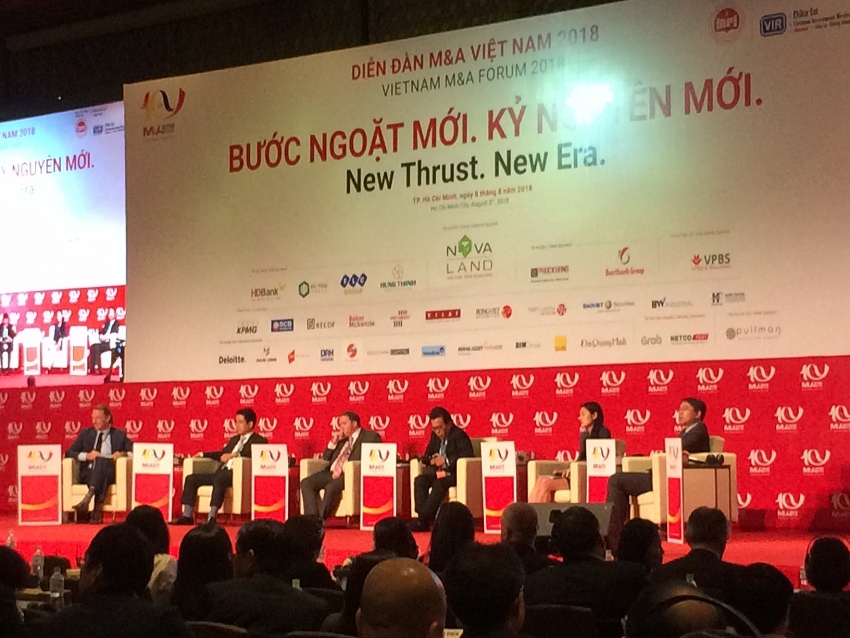Vietnam M&A Forum: deals driven by a 100-million market
 |
| The 100 million Vietnamese consumers are a highlight among international investors |
Dominic Scriven - Executive chairman, Dragon Capital Group
Vietnam is the market for M&A, however, one of the most important things is setting a price tag on a transaction. In many cases, sellers offer a very high price while the buyers always want a lower price. These things make negotiations difficult, and that is why the two sides must make in-depth research and understand each other, otherwise they cannot agree on any issue.
Many M&A deals in Vietnam take place in the fast moving consumer goods segment, despite the fact that the number of successful deals in this field has been getting lower. In general, I see that we will move from FDI and FII to strategic investment in the coming time.
Masataka Sam Yoshida - Senior managing director, Recof Corporation
In the Vietnamese M&A market, Japanese investors are new arrivals compared to those from South Korea or Singapore. This is due to the lack of information. Japanese investors are very careful and conservative in their investment, which makes decision making longer. We need as much information as possible about our target partners before making a decision.
Previously, Japanese investors were very strong in M&A activities. However, successful deals are getting fewer, only one third compared to earlier times. I see that the Vietnamese M&A market is very active, even though many Vietnamese company owners are still hesitant.
Neil MacGregor - Managing director, Savills Vietnam
Vietnamese investors are very good at approaching land funds. Especially in Ho Chi Minh City, the demand for land increased five-fold compared to 2013, in both office and residential projects. M&A in the Vietnamese real estate market is attractive because it offers higher yields than other countries like Hong Kong or Singapore. However, I see that the greatest challenge for investors lies in acquiring land funds.
I think that risk management is more important than the transaction price. The buyers I see will be ready to pay a higher rate if they see lower risk in an investment. I think that the Vietnamese M&A market is now in the spotlight, however, we should think more about the possibility to approach successful deals and offer more opportunities for foreign investors.
Le Viet Anh Phong - Partner, head of Financial Advisory, Deloitte Vietnam
The Vietnamese M&A market is very challenging and in order to approach the market, companies must have many channels. Meanwhile, local companies have set up a system of channels to distribute their goods and this is a major advantage for local companies.
I think that one of the key challenges for M&A is the transaction’s valuation because sellers always compare their deals to others and in many cases they do not have enough information to make a decision and are not ready to share information. Despite the inherent risks and the lingering issues with valuation, M&A is still the fastest way for companies to increase their capacity and accelerate growth.
Fan Li - Executive director, Warburg Pincus
Warburg Pincus has been present in Hong Kong since 1994. Today, Vietnam is an important market for us in the ASEAN as we are expanding operations in the country.
Warburg Pincus is also active in the Vietnamese M&A market, which provides sufficient information to evaluate target companies. Last year, we have completed a successful deal, securing profitability in the capital market. We believe that Vietnam has ample potential for growth. The country has been on the radars of foreign investors in recent years.
Jiun Park - Deputy director, Global M&A Facilitation Centre, KOTRA
South Korean investors are changing their investment strategy from labour-intensive sectors to growing domestic markets, especially in the fields of logistics, infrastructure, and pharmaceuticals. An increasing number of Korean small- and medium-sized enterprises (SMEs) are keen on the Vietnamese market.
South Korean investors are becoming more active in Vietnam’s M&A market with an estimated value of $300 million last year. South Korean investors have clinched deals worth $200 million in the first half of 2018. After the deals, they have extended their reach to regional markets like Myanmar, Laos, and Cambodia. There are immense opportunities for partnerships between the two sides, especially as South Korean companies are seeking opportunities to expand in the region.
What the stars mean:
★ Poor ★ ★ Promising ★★★ Good ★★★★ Very good ★★★★★ Exceptional
Related Contents
Latest News
More News
- Ho Chi Minh City hits $8.37 billion in FDI (December 29, 2025 | 08:28)
- Tax sector wraps up 2025 and sets priorities for next year (December 25, 2025 | 14:00)
- Heavy industries set for pilot greenhouse gas quotas (December 25, 2025 | 10:00)
- $250 million deal targets women-owned SMEs, sustainable agriculture (December 22, 2025 | 17:40)
- UOB sees Vietnam growth easing in fourth quarter (December 22, 2025 | 17:39)
- Government moves to establish International Financial Centre (December 21, 2025 | 21:00)
- Vietnam's IFC to target global investment flows (December 21, 2025 | 18:00)
- Ha Tinh breaks ground on major Vingroup industrial and energy projects (December 19, 2025 | 18:24)
- EVN launches major power infrastructure projects nationwide (December 19, 2025 | 18:17)
- VAL inaugurates second production line to meet domestic animal feed demand (December 19, 2025 | 16:37)

 Tag:
Tag:
























 Mobile Version
Mobile Version